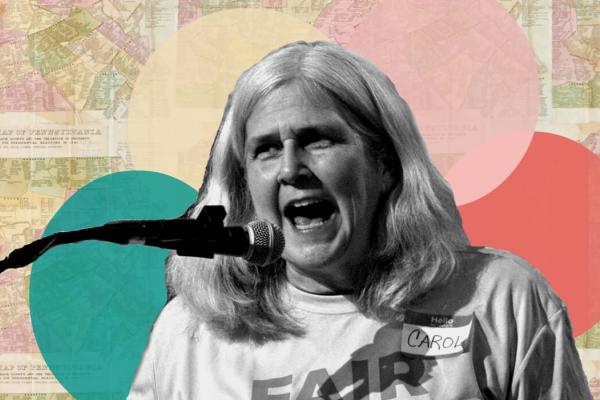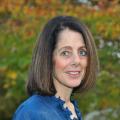IN THE FIGHT against gerrymandered electoral districts in Pennsylvania, Carol Kuniholm is a rock star.
A former English professor and youth pastor, Kuniholm now spends much of her time traveling the Keystone State, explaining to hundreds of listeners how politicians have deliberately redrawn Pennsylvania’s voting districts to favor their own party. Using charts and graphs, Kuniholm shows, in lucid detail, how the disfigured districts chill democracy. “Democracy means voters choose their politicians,” explains the website of Fair Districts PA, an anti-gerrymandering organization Kuniholm co-founded in 2016. “Current Pennsylvania law lets politicians choose their voters.”
Plain-spoken and precise, Kuniholm hasn’t changed her demeanor since taking charge of the state movement, though she did make one concession to her newfound fame: “I bought a suit,” she confesses.
On Sundays, she and her husband, Whitney, can be found in the pews of the Episcopal Church of the Good Samaritan in the Philadelphia suburbs, or praying with parishioners near the front (the writer also attends that congregation). Kuniholm grew up attending a Christian Missionary Alliance church, went to a Wesleyan college, and later was involved with Evangelicals for Social Action. By her own description, Kuniholm considers herself “strongly within the historic evangelical tradition.”
All in all, in the nonstop theater of the Pennsylvania political arena—sometimes more barroom brawl than government by the people—Kuniholm is an unlikely addition.
“The cornerstone of corruption”
This summer, the U.S. Supreme Court is expected to deliver its decision on two cases of partisan gerrymandering: one against Republican redistricting in Wisconsin, the other against Democratic redistricting in Maryland. But manipulating voting districts by drawing boundaries that favor one party over the other goes back to Massachusetts Gov. Elbridge Gerry, who, in 1812, employed the strategy to create his own misshapen district. (Critics thought Gerry’s oddly shaped district resembled a salamander and nicknamed it “the Gerry-mander.”)
In 1965, the Voting Rights Act ended the then-common practice of intentionally dividing neighborhoods where minorities live across several voting districts to weaken their voting power. But while racial gerrymandering is prohibited, partisan gerrymandering—for which there is no federal limit—often achieves the same effect. “Particularly in the South, where racial identity and partisan identity frequently overlap, partisan gerrymandering is a way of reducing the voice of minority constituencies,” said Tom Wolf, counsel with the Brennan Center for Justice at New York University School of Law.
Though partisans looking for an advantage can skew district maps anywhere, Pennsylvania, a traditional battleground state, is a standout. According to a 2017 report by researchers at the Brennan Center, Pennsylvania joined North Carolina and Michigan as the states whose voting districts showed the most “extreme levels of partisan bias.” In Pennsylvania, this has given Republicans an ongoing advantage in elections, resulting in a share of seats out of sync with their numbers. “Pennsylvania sends too many Republicans to Washington,” said Philadelphia Inquirer staff writer Jonathan Lai after analyzing data from the Brennan Center and the Gerrymandering Project at Princeton University. “That’s not a partisan attack. That’s just math.”
“This is the cornerstone of corruption in Pennsylvania, and if you could change this, you would change Pennsylvania politics,” a group of retired district attorneys told Kuniholm when she first began working against gerrymandering.
Stop pondering, get busy
Though Kuniholm never envisioned herself getting involved with politics, her awareness of inequality began in childhood. Raised with her three siblings by her hard-working grandmother in the wealthy suburbs of New York City, Kuniholm recalled the generosity of teachers who often conjured up an extra ticket for a class trip. And she knew what it was like to benefit from government support: “We had social workers and food stamps, and I think that was a good investment,” said Kuniholm. “When people make comments about people who need help, I think, ‘You could need help. How dare you assume that people who need help are somehow less than you or lazy? Don’t assume you are a better person.’”
Later, as a youth pastor, Kuniholm began building relationships with families in Kensington, an economically struggling neighborhood where her suburban church had a partnership. Over time, she saw how inadequate housing and underfunded schools kept the neighborhood locked in poverty. But unlike her own experience, government institutions—such as the educational and justice systems—failed to provide meaningful support for the families in Kensington.
Kuniholm tried to supply some of that missing support: She got to know a single mother and her kids, offering educational games for the children, sleepovers at the Kuniholm residence, and encouragement for the mother as she worked on her GED. But Kuniholm realized volunteering wasn’t going to do much good without altering the political calculus. “Kids need schools that function,” she explained, especially kids who may have language barriers, lag in reading skills, or have emotional difficulties. Kuniholm discovered that Pennsylvania has among the most inequitable school funding in the country—something unlikely to change with a state legislature she found to be systemically unresponsive to either the needs or the opinions of their constituents.
When her parish job ended, Kuniholm wanted to help, but she was unsure how to be most effective. She joined a group of like-minded locals trying to map out the root causes of economic injustice in the shadow of the Occupy Wall Street movement. “The more we talked, the more I thought things were really inequitable, and I didn’t know how to fix them,” she explained. Eventually, she decided she needed to do more than sip coffee and ponder. “We’re not doing things, and I prefer to do things.”
Kuniholm searched for a nonpartisan, civically engaged organization and wound up at a local meeting of the League of Women Voters, where she later became the state election reform specialist. As she began to understand the political landscape more fully, she said, she realized that without a gerrymandering fix, solving the other inequities that had long troubled her might not be possible.
God and gerrymandering
Since then, Kuniholm has pursued the goal of ending gerrymandering in Pennsylvania politics with remarkable, nonpartisan tenacity.
When she’s not testifying before a state senate hearing in Harrisburg or meeting with a member of the media, Kuniholm spends a lot of her time driving alone across Pennsylvania to address audiences gathered in school auditoriums and churches, staying in the homes of friends and supporters. Though Kuniholm doesn’t attend all the meetings for Fair Districts PA, the group has logged at least 340 gatherings across the state, with more than 18,000 people showing up.
At these meetings, Kuniholm provides examples of volunteers who share resolutions in municipalities across the state, make appointments with their legislators, start petition drives, and begin showing up at local school board meetings and other government functions. Then she challenges her audience to consider how they can help. And it works: As she crosses the state, she constantly runs into volunteers who were inspired to get involved after they heard her speak.
“Part of the reason for her success, and for ours, is that she doesn’t take ‘no’ or ‘it’s impossible’ for an answer,” said Patrick Beaty, a retired lawyer who is helping Fair Districts PA implement a legislative strategy. “If you are a person who has been involved in other legislative issues, you might be cynical or discouraged. Her optimism and can-do attitude is just what we need at this time.”
Another reason for Kuniholm’s perseverance? Her faith. In a winter presentation at her home congregation titled “Justice and Gerrymandering: Faith Perspectives on Redistricting Reform,” Kuniholm shared scripture passages—Isaiah 1:7, Micah 6:8, and Amos 5:24—that have shaped her work on behalf of those on the margins, whether they are challenged by poverty, educational inequality, or a system she believes is slanted to favor whatever political party is in power.
“For me this is an issue of loving your neighbor,” Kuniholm later explained. While buying a school uniform for someone who can’t afford it or inviting them to your house for a long weekend is a start, Kuniholm said that “at a certain point loving my neighbor has to go beyond practical demonstrations. We need to look at the policies that hold them in place.”
Working collaboratively with the advocacy arm of the Pennsylvania Council of Churches, Kuniholm has prepared a video and a study guide for churches and other faith communities that want to delve further into the issue from a faith perspective. The Fair Districts PA initiative has also been endorsed by denominations and religious organizations across the state.
Demanding a place
Earlier this year, the Pennsylvania Supreme Court ruled that the congressional maps drawn in 2011 were partisan and unfair to voters and ordered a new map to be drawn by a Stanford Law School professor who has drawn court-adjudicated district maps in other places. Though Republican leaders in the Pennsylvania legislature appealed all the way to the Supreme Court, the new maps remain in place.
But according to Kuniholm, it’s “not a permanent solution.” Currently, the districts are redrawn by legislators every 10 years to account for changes in the population; without further laws against gerrymandering, the next time districts are drawn, they will be drawn by the same manipulative process. For Kuniholm, a longer-term fix would involve putting redistricting of congressional and legislative boundaries in the hands of a citizen commission rather than that of lawmakers. In its 2017 study, researchers at the Brennan Center found that maps created by independent commissions, courts, or split-party state governments showed significantly less bias. A citizen commission could reconfigure both the Pennsylvania legislative maps and the congressional boundaries.
This strategy—using an independent commission to draw electoral districts—has been proposed in several bills currently being debated by Pennsylvania legislators. Though the future of these bills is uncertain, Fair Districts PA has been instrumental in rallying citizens to support the legislation, says state Rep. Steve Samuelson, a Lehigh Valley lawmaker who has been working on redistricting reform for almost two decades. “We once again have tremendous support,” said Samuelson, adding that 109 state representatives have now signed on in support of the move. “I’m sure that many of my colleagues have signed on to the bill because local citizens have sat down with them and educated them. Public support has had a tremendous effect on the legislation.”
Philadelphia-based Keith Forsyth, a retired engineer who volunteers as a county coordinator for Fair Districts PA, sees the anti-gerrymandering effort as one that is potentially winnable. A longtime political progressive, Forsyth firmly believes that grassroots organizing is a more effective route to change than others, including lobbying.
So does Kuniholm. “While paid lobbyists have a great deal of influence in Harrisburg, at the end of the day these legislators have to go home and be re-elected in their own districts,” she explained.
There are times when her schedule feels completely out of control, admits Kuniholm, but it’s worth it. “I feel sacrificially called to this,” she said. “It’s sacrificial work for everyone involved.” And she credits the Pennsylvania League of Women Voters volunteers who assisted her at the beginning and the wide network of citizens who have shown up at meetings and asked how they can get involved with Fair Districts.
In the meantime, this citizen-activist is inspired by the many ways in which those formerly on the outside are asking, sometimes demanding, a place at the table. Though political insiders have long assumed that they have the right to keep others out, Kuniholm believes “everything has made it clear that women, people of color, and others are going to have their say. I know it troubles them, but it has to change—and it will change. These wonderful people want to see it happen.”

Got something to say about what you're reading? We value your feedback!

